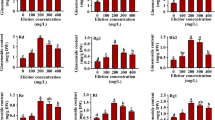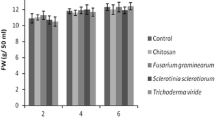Abstract
Plants generally produce secondary metabolites in nature as a defense mechanism against pathogenic and insect attack. In this study, we applied several abiotic elicitors in order to enhance growth and ginseng saponin biosynthesis in the hairy roots of Panax ginseng. Generally, elicitor treatments were found to inhibit the growth of the hairy roots, although simultaneously enhancing ginseng saponin biosynthesis. Tannic acid profoundly inhibited the hairy root growth during growth period. Also, ginseng saponin content was not significantly different from that of the control. The addition of selenium at inoculum time did not significantly affect ginseng saponin biosynthesis. However, when 0.5 mM selenium was added as an elicitor after 21 d of culture, ginseng saponin content and productivity increased to about 1.31 and 1.33 times control levels, respectively. Also, the addition of 20μM NiSO4 resulted in an increase in ginseng saponin content and productivity, to about 1.20 and 1.23 times control levels, respectively, and also did not inhibit the growth of the roots. Sodium chloride treatment inhibited hairy root growth, except at a concentration of 0.3% (w/v). Increases in the amounts of synthesized ginseng saponin were observed at all concentrations of added sodium chloride. At 0.1% (w/v) sodium chloride, ginseng saponin content and productivity were increased to approx, 1.15 and 1.13 times control values, respectively. These results suggest that processing time for the generation of ginseng saponin in a hairy root culture can be reduced via the application of an elicitor.
Similar content being viewed by others
References
Verpoorte, R., van der Heijden, R., ten Hoopen, H. J. G., and Memelink, J. (1999), Biotechnol. Lett. 21, 467–479.
Lee, J. H., Loc, N. H., Kwon, T. H., and Yang, M. S. (2004), Biotech. Bioprocess Eng. 9(1), 12–16.
Banthorpe, D. V. (1994), Nat. Prod. Rep. 11(3), 303–328.
Canto-Canche and Loyola-Vargas, V. M. (1999), In: Chemicals Via Higher Plant Bioengineering (Advances in Experimental Medicine and Biology, 464), Kluwer, pp. 235–275.
Jeong, G. T., Park, D. H., Ryu, H. W., Hwang, B., and Woo, J. C. (2004) Appl. Biochem. Biotechnol. 116, 1193–1203.
Furuya, T., Kojima, H., Syono, K., and Nishio, M. (1973), Planta Med. 47, 183–187.
Giria, A. and Narasu, M. L. (2000), Biotechnol. Adv. 18, 1–22.
Ramachandra, R. S. and Ravishankar, G. A. (2002), Biotechnol. Adv. 20(2), 101–153.
Akimoto, C., Aoyagi, H., and Tanaka, H. (1999), Appl. Microbiol. Biotechnol. 52, 429–436.
Lu, M. B., Wong, H. L., and Teng, W. L. (2001), Plant Cell Rep. 20, 674–677.
Seigler, D. S. (1995), In: Plant Secondary Metabolis, Kluwer, London.
Lopez-Bucio, J., Cruz-Ramirez, A., and Herrera-Estrella, L. (2003), Curr. Opin. Plant Biol. 6, 280–287.
Witte, C.-P., Tiller, A. A., Taylor, M. A., and Davies, H. V. (2002), Plant Cell Tiss. Org. 68, 103–104.
Gerendas, J., Polacco, J. C., Freyermuth, S. K., and Sattelmacher, B. (1999), J. Plant Nutr. Soil Sci. 162, 241–256.
Arshi, A., Abdin, M. Z., and Iqbal, M. (2002), Biol. Plantarum 45(2), 295–298.
Wu, J. and Zhong, J. J. (1999), J. Biotechnol. 68, 89–99.
Jung, N. P. and Jin, S. H. (1996), Korean J. Ginseng Sci. 20(4), 431–471.
Jeong, G. T. and Park, D. H. (2005), Biotech. Bioprocess Eng. 10, 73–77.
Jeong, G. T. (2004), PhD Dissertation, Chonnam National University, Gwangju, Korea.
Author information
Authors and Affiliations
Corresponding author
Rights and permissions
About this article
Cite this article
Jeong, GT.A., Park, DH.e. Enhanced secondary metabolite biosynthesis by elicitation in transformed plant root system. Appl Biochem Biotechnol 130, 436–446 (2006). https://doi.org/10.1385/ABAB:130:1:436
Issue Date:
DOI: https://doi.org/10.1385/ABAB:130:1:436




